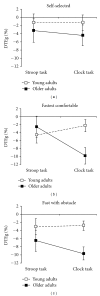Effects of gait and cognitive task difficulty on cognitive-motor interference in aging
- PMID: 23209905
- PMCID: PMC3503314
- DOI: 10.1155/2012/583894
Effects of gait and cognitive task difficulty on cognitive-motor interference in aging
Abstract
Although gait-related dual-task interference in aging is well established, the effect of gait and cognitive task difficulty on dual-task interference is poorly understood. The purpose of this study was to examine the effect of gait and cognitive task difficulty on cognitive-motor interference in aging. Fifteen older adults (72.1 years, SD 5.2) and 20 young adults (21.7 years, SD 1.6) performed three walking tasks of varying difficulty (self-selected speed, fast speed, and fast speed with obstacle crossing) under single- and dual-task conditions. The cognitive tasks were the auditory Stroop task and the clock task. There was a significant Group × Gait Task × Cognitive Task interaction for the dual-task effect on gait speed. After adjusting for education, there were no significant effects of gait or cognitive task difficulty on the dual-task effects on cognitive task performance. The results of this study provide evidence that gait task difficulty influences dual-task effects on gait speed, especially in older adults. Moreover, the effects of gait task difficulty on dual-task interference appear to be influenced by the difficulty of the cognitive task. Education is an important factor influencing cognitive-motor interference effects on cognition, but not gait.
Figures

Similar articles
-
Task matters: an investigation on the effect of different secondary tasks on dual-task gait in older adults.BMC Geriatr. 2021 Sep 25;21(1):510. doi: 10.1186/s12877-021-02464-8. BMC Geriatr. 2021. PMID: 34563129 Free PMC article.
-
The Effect of Cognitive Task, Gait Speed, and Age on Cognitive-Motor Interference during Walking.Sensors (Basel). 2023 Aug 24;23(17):7368. doi: 10.3390/s23177368. Sensors (Basel). 2023. PMID: 37687823 Free PMC article.
-
Effect of type of cognitive task and walking speed on cognitive-motor interference during dual-task walking.Neuroscience. 2014 Feb 28;260:140-8. doi: 10.1016/j.neuroscience.2013.12.016. Epub 2013 Dec 15. Neuroscience. 2014. PMID: 24345478
-
Dual-task mobility among individuals with chronic stroke: changes in cognitive-motor interference patterns and relationship to difficulty level of mobility and cognitive tasks.Eur J Phys Rehabil Med. 2018 Aug;54(4):526-535. doi: 10.23736/S1973-9087.17.04773-6. Epub 2017 Sep 25. Eur J Phys Rehabil Med. 2018. PMID: 28949119
-
Cognitive Involvement in Balance, Gait and Dual-Tasking in Aging: A Focused Review From a Neuroscience of Aging Perspective.Front Neurol. 2018 Oct 29;9:913. doi: 10.3389/fneur.2018.00913. eCollection 2018. Front Neurol. 2018. PMID: 30425679 Free PMC article. Review.
Cited by
-
Dual-task costs in aging are predicted by formal education.Aging Clin Exp Res. 2016 Oct;28(5):959-64. doi: 10.1007/s40520-015-0385-5. Epub 2015 May 26. Aging Clin Exp Res. 2016. PMID: 26006256 Free PMC article.
-
Feasibility of dual-task gait to estimate Alzheimer's related cognitive decline in Down syndrome.Alzheimers Dement (Amst). 2020 Aug 25;12(1):e12092. doi: 10.1002/dad2.12092. eCollection 2020. Alzheimers Dement (Amst). 2020. PMID: 32875058 Free PMC article.
-
Changes in Standing and Walking Performance Under Dual-Task Conditions Across the Lifespan.Sports Med. 2015 Dec;45(12):1739-58. doi: 10.1007/s40279-015-0369-9. Sports Med. 2015. PMID: 26253187 Free PMC article. Review.
-
The effect of mental tracking task on spatiotemporal gait parameters in healthy younger and middle- and older aged participants during dual tasking.Exp Brain Res. 2019 Dec;237(12):3123-3132. doi: 10.1007/s00221-019-05659-z. Epub 2019 Sep 26. Exp Brain Res. 2019. PMID: 31559447
-
The Effects of Cognition and Vision While Walking in Younger and Older Adults.Sensors (Basel). 2024 Dec 5;24(23):7789. doi: 10.3390/s24237789. Sensors (Basel). 2024. PMID: 39686326 Free PMC article.
References
-
- Patla AE, Shumway-Cook A. Dimensions of mobility: defining the complexity and difficulty associated with community mobility. Journal of Aging and Physical Activity. 1999;7(1):7–19.
-
- Al-Yahya E, Dawes H, Smith L, Dennis A, Howells K, Cockburn J. Cognitive motor interference while walking: a systematic review and meta-analysis. Neuroscience and Biobehavioral Reviews. 2011;35(3):715–728. - PubMed
-
- Shumway-Cook A, Woollacott M, Kerns KA, Baldwin M. The effects of two types of cognitive tasks on postural stability in older adults with and without a history of falls. Journals of Gerontology Series A. 1997;52(4):M232–M240. - PubMed
-
- Bock O, Engelhard K, Guardiera P, Allmer H, Kleinert J. Gerontechnology and human cognition. IEEE Engineering in Medicine and Biology Magazine. 2008;27(4):23–28.
-
- Weerdesteyn V, Schillings AM, van Galen GP, Duysens J. Distraction affects the performance of obstacle avoidance during walking. Journal of Motor Behavior. 2003;35(1):53–63. - PubMed
LinkOut - more resources
Full Text Sources

